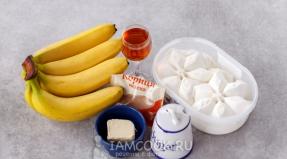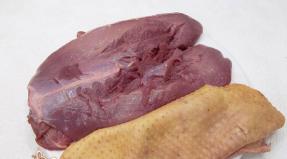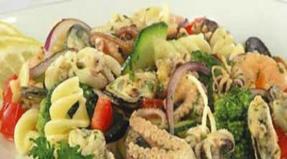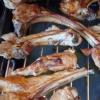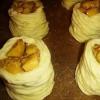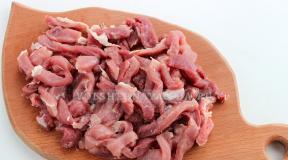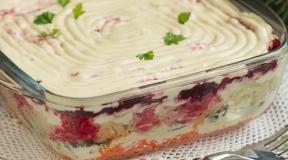How to knead homemade noodles. homemade noodles
is, first of all, homemade chicken broth and, of course, noodles from handmade dough. Now there are many varieties and types of ready-made noodles (paste) for sale for different tastes and budgets, but real home cooking encourages us to be able to make it ourselves. Well, or at least imagine how it's done. Therefore, I show how the dough for homemade noodles is prepared, let it be in the piggy bank of your recipes.
You will need:
- egg 1 pc
- water 1 tbsp.
- pinch of salt
- flour 7-8 tbsp with a slide
Step by step photo recipe:
Sift into a bowl flour make a hole in the flour and break it into it egg. Add half a shell (1 tbsp) water, pinch salt and a few drops olive oil. Knead the dough with a knife, gradually mixing the flour into the egg. When the dough is still semi-liquid, but you can already take it in your hand, transfer it to a floured table or board on which you will knead it.
Knead the dough with your hands, constantly adding flour. This can be done on the board, and take the dough in hand. Like this.

It is not necessary to add all the flour, as soon as the dough becomes dense and elastic enough, form a ball out of it, wrap it in cling film so that it does not dry out, let it rest for 5-10 minutes.

To roll out the dough, cut the ball into 4 pieces and form 4 small balls.

Roll them out one by one. First flatten the ball into a cake, and then roll out with a rolling pin on the board from the middle to the edges, adding flour. The thickness of the rolled cakes can be different. Usually for noodles I roll them 26-28 cm in diameter. This is a denser dough. And when I make homemade or, then I roll out the dough until transparent. The photo shows that the dough transmits light.

As a result, you will get four rolled cakes. Now you can cut the noodles the way you like. For example, cut a cake into strips. Stack the strips on top of each other. And cut into strips with a knife - this is classic form of homemade noodles.

There is another way to cut, it saves time. Stack the rolled cakes on top of each other and roll into a tube. Cut the noodles obliquely from one side of the tube, then from the other, adjusting the width and length.

Lay the noodles out on a flat surface, using your hands to spread them apart. Usually properly kneaded and rolled noodles separate easily and do not stick together.

The noodles are ready and you can already cook them right now if you have the broth. I usually put the broth to boil first, and while it boils, I knead the noodles. How to cook the broth, see ⇒
Advice:before putting the noodles into the boiling broth, make them welding- in a separate saucepan, bring water (1 liter) to a boil and put the noodles in boiling water. Stir so it doesn't stick to the bottom of the pot. As soon as the water boils again, drain the noodles into a colander and only then lower them into the boiling broth. This is necessary in order to to keep the broth clear.


Fresh chopped noodles cook very quickly. After you throw it into the boiling broth, just wait until it floats to the surface.

Homemade noodles keep very well. My grandmother made dough for noodles from 10 eggs and, after cutting, dried it in the oven, put it in a clean, dry cloth bag and stored it that way. You can lay the noodles out on a flat surface and dry them at room temperature by lifting and stirring occasionally. Dry noodles can be stored in a glass jar, tightly closed. Dry noodles should be cooked in the same way as fresh noodles, but longer. Let it boil for 5-7 minutes. Dry noodles will no longer float to the surface of the broth.


This is what they call homemade noodles. Grandmother cooked it from chicken, which ran under the window in the morning. In those years, even in cities, people living in a private house always raised chickens and planted a garden. At the table, the grandmother served noodles with part of the chicken in the plate and did not remove the meat from the bone. I have preserved a plate from the service, which was presented by my grandmother to my mother for the wedding - Dulevo Porcelain 1957. In it, I present real homemade noodles - Noodles with a capital letter.

Bon Appetit!

Homemade noodles. Short recipe.
You will need:
- egg 1 pc
- water 1 tbsp.
- pinch of salt
- olive oil 0.5 tsp (or any vegetable)
- flour 7-8 tbsp with a slide
Noodles from this amount of products are enough for 5-6 liters of broth. If you have less broth, then dry the remaining noodles and use next time.
Sift flour into a bowl , make a well in the flour and break the egg into it. Add half a shell ( 1 tablespoon) of water, a pinch of salt and a few drops of olive oil. Knead the dough with a knife, gradually mixing the flour into the egg. When the dough is still semi-liquid, but you can already take it in your hand, transfer it to a floured table or board on which you will knead it. Knead the dough with your hands, constantly adding flour. It is not necessary to add all the flour, as soon as the dough becomes dense and elastic enough, form a ball out of it, wrap it in cling film so that it does not dry out, let it rest for 5-10 minutes. Cut the ball into 4 parts, and form 4 small balls. Roll them one by one from the middle to the edges until 26-28 cm in diameter , sprinkling flour. Cut the tortillas into noodles of a length and width convenient for you. Lay the noodles out on a flat surface, using your hands to spread them apart. Boil the noodles before putting them into the boiling broth . Boil the noodles in the broth until they float to the surface.
In contact with
Today it seems to all of us that noodles are one of the most primordial Russian dishes, one of the most popular, that dishes with noodles have always existed. Yes, not so. You may be surprised, but the first mention of noodles dates back to the 16th century, and before that, if noodles were known, they could not boast of special popularity and prevalence. According to V. Pokhlebkin, the Russians borrowed noodles from the Tatars, but gave it their own special flavor. And already in the 17th century, noodles became not only one of the most common dishes in everyday Russian cuisine, but, having gained popularity, fell from the table into folklore. What are the mere teasers about the Vladimir townspeople who chop noodles with an ax! We, the descendants, spoiled by the delights of many cuisines of the world, cannot be surprised at all with noodles. But it’s easy to seduce with noodles, and seat at the table with just the aroma of properly cooked noodles even now. The main thing is that the noodles are homemade, cooked with love and care. Let's try to find out and remember how to cook homemade noodles today.
 At first, the most superficial glance, the preparation of noodles is not fraught with any special secrets. Well, really, is it difficult to mix flour, salt, egg and water, roll out the resulting dough, and cut it into noodles? Even a child can handle it, many will say. And they will be wrong. In the preparation of noodles, every step is important. Correct and accurate selection of verified ingredients, long and thorough dough kneading, proper dough rest and rolling, proper cutting and drying. Only knowing all the subtleties of cooking will allow you to fully enjoy truly delicious, strong homemade noodles. Violation of the technology most often leads to obtaining a soft, strangely blurred substance in the soup, which you can’t call noodles or dare to bring to your mouth.
At first, the most superficial glance, the preparation of noodles is not fraught with any special secrets. Well, really, is it difficult to mix flour, salt, egg and water, roll out the resulting dough, and cut it into noodles? Even a child can handle it, many will say. And they will be wrong. In the preparation of noodles, every step is important. Correct and accurate selection of verified ingredients, long and thorough dough kneading, proper dough rest and rolling, proper cutting and drying. Only knowing all the subtleties of cooking will allow you to fully enjoy truly delicious, strong homemade noodles. Violation of the technology most often leads to obtaining a soft, strangely blurred substance in the soup, which you can’t call noodles or dare to bring to your mouth.
 And how many dishes you can cook if you managed to chop the right homemade noodles! Soups are traditionally prepared with noodles, here we are waiting for healing chicken noodles and unusually tasty and fragrant duck noodles, breathtaking noodles with wild mushrooms and sweet dairy noodles. But homemade noodles are not suitable for soups alone. Put it in lamb fat, and serve it with tender lamb ribs, boil it in a strong broth, and at the last moment put it on a baking sheet with a roasted pig, put it in a pot, pour it with milk, sprinkle with grated cheese, and bake it in the oven. For a long time you can list dishes that noodles will decorate with themselves and give them a new taste. And add fragrant herbs, spicy vegetables, and fragrant spices to the noodles, and you yourself will be surprised how endless the number of unique flavors that such a simple, familiar to everyone homemade noodles can please you.
And how many dishes you can cook if you managed to chop the right homemade noodles! Soups are traditionally prepared with noodles, here we are waiting for healing chicken noodles and unusually tasty and fragrant duck noodles, breathtaking noodles with wild mushrooms and sweet dairy noodles. But homemade noodles are not suitable for soups alone. Put it in lamb fat, and serve it with tender lamb ribs, boil it in a strong broth, and at the last moment put it on a baking sheet with a roasted pig, put it in a pot, pour it with milk, sprinkle with grated cheese, and bake it in the oven. For a long time you can list dishes that noodles will decorate with themselves and give them a new taste. And add fragrant herbs, spicy vegetables, and fragrant spices to the noodles, and you yourself will be surprised how endless the number of unique flavors that such a simple, familiar to everyone homemade noodles can please you.
Today, Culinary Eden has carefully collected and recorded for you the most important secrets and tips, as well as several time-tested recipes that will easily tell novice housewives how to cook homemade noodles.
 1. Like most other dough products, the noodles are rolled out on a board using a rolling pin. V. Pokhlebkin strongly advised using for these purposes a wooden board 50x75 cm, preferably carved from linden, aspen, birch. But the connoisseur of Russian cooking scolded plastic boards, rightly believing that their elasticity and pliability are incomparable with the corresponding qualities of a wooden board. However, plastic boards are, of course, more hygienic. Any rolling pin is suitable for rolling out noodle dough, although the rolling pin is monolithic, you will surely find it more convenient. On the other hand, the European rolling pin will require you to apply much less effort when rolling out the dough. For cutting noodles, you can use ordinary sharpened table knives, but it is most convenient to use round dough or pizza knives. Such knives are both straight and curly - allowing you to cut the noodles of the original wavy shape. Those who often cook noodles can be advised to purchase special mechanical or electric machines that will allow you to easily roll out thinly and evenly cut the dough into noodles.
1. Like most other dough products, the noodles are rolled out on a board using a rolling pin. V. Pokhlebkin strongly advised using for these purposes a wooden board 50x75 cm, preferably carved from linden, aspen, birch. But the connoisseur of Russian cooking scolded plastic boards, rightly believing that their elasticity and pliability are incomparable with the corresponding qualities of a wooden board. However, plastic boards are, of course, more hygienic. Any rolling pin is suitable for rolling out noodle dough, although the rolling pin is monolithic, you will surely find it more convenient. On the other hand, the European rolling pin will require you to apply much less effort when rolling out the dough. For cutting noodles, you can use ordinary sharpened table knives, but it is most convenient to use round dough or pizza knives. Such knives are both straight and curly - allowing you to cut the noodles of the original wavy shape. Those who often cook noodles can be advised to purchase special mechanical or electric machines that will allow you to easily roll out thinly and evenly cut the dough into noodles.
 2. The choice of flour for making noodles is most often limited only by your imagination. The thing is that, unlike Italian pasta or macaroni, noodles do not require a certain type of a certain type of flour at all. Excellent tasty noodles can be made from wheat, buckwheat or oatmeal. Especially delicious is the noodles, in the preparation of which two or three different types of flour are used. The same can be said about the type of flour. Good noodles can be made from first grade flour, and from coarser flour. Noodles turn out great if you add a little flour of the second grade to the flour of the first grade or finely ground semolina in a coffee grinder. But unlike pasta, when preparing noodles, eggs are necessarily used, often completely replacing the entire liquid part of the dough with them. The task of the eggs is to make the dough as strong and dense as possible so that it does not fall apart in the water.
2. The choice of flour for making noodles is most often limited only by your imagination. The thing is that, unlike Italian pasta or macaroni, noodles do not require a certain type of a certain type of flour at all. Excellent tasty noodles can be made from wheat, buckwheat or oatmeal. Especially delicious is the noodles, in the preparation of which two or three different types of flour are used. The same can be said about the type of flour. Good noodles can be made from first grade flour, and from coarser flour. Noodles turn out great if you add a little flour of the second grade to the flour of the first grade or finely ground semolina in a coffee grinder. But unlike pasta, when preparing noodles, eggs are necessarily used, often completely replacing the entire liquid part of the dough with them. The task of the eggs is to make the dough as strong and dense as possible so that it does not fall apart in the water.
 3. Let's try to knead the simplest noodle dough. Take a glass of sifted wheat flour, pile it on a board, make a small indentation on top and pour in one egg. Cold egg, this is important! Then add a couple of tablespoons of ice water and immediately start kneading your dough, being careful not to spill the liquid onto the board, but to mix it all with flour. Knead the dough for as long and as thoroughly as you can. Even if it seems to you that there is not enough liquid, that there is too much unsoaked flour left, drive these impressions away, and try to keep yourself from wanting to splash extra water. At most, you can add another spoonful of ice water, everything else should be done by the strength of your hands. The stronger and more thoroughly you knead and knead the dough, the smoother, denser and more elastic it will turn out. Wrap the finished dough with cling film and leave in a cool place for 20-30 minutes. During this time, the dough will completely rise, ripen, become elastic and soft.
3. Let's try to knead the simplest noodle dough. Take a glass of sifted wheat flour, pile it on a board, make a small indentation on top and pour in one egg. Cold egg, this is important! Then add a couple of tablespoons of ice water and immediately start kneading your dough, being careful not to spill the liquid onto the board, but to mix it all with flour. Knead the dough for as long and as thoroughly as you can. Even if it seems to you that there is not enough liquid, that there is too much unsoaked flour left, drive these impressions away, and try to keep yourself from wanting to splash extra water. At most, you can add another spoonful of ice water, everything else should be done by the strength of your hands. The stronger and more thoroughly you knead and knead the dough, the smoother, denser and more elastic it will turn out. Wrap the finished dough with cling film and leave in a cool place for 20-30 minutes. During this time, the dough will completely rise, ripen, become elastic and soft.
4. Is your dough ready? Now you have to roll it out and cut noodles out of it. Sprinkle the board with flour, put a dough ball on it, flatten it a little with your hands, sprinkle with flour and start rolling it out using a rolling pin rubbed with flour. First roll out carefully from the center to the edges, trying to give your dough a rounded shape, then roll it out, leaning as hard as possible on the rolling pin, trying to roll out the dough as thinly as possible. When the thickness of the dough sheet reaches a couple of millimeters, again begin to be especially careful, trying not to tear the thin dough sheet. The thinner you can roll out the dough, the better. Remember that even two-millimeter noodles will swell when boiled and turn into a poorly cooked sticky four-millimeter piece of dough.
 5. Rolled out? Subtle enough? So almost everything is ready! It remains only to cut our noodles. If you are using round or special shaped knives, then just start cutting the noodles to the thickness you need for your goal. If you want to cut traditional Russian noodles, then first let the dough sheet lie down for 10 - 15 minutes and dry slightly. Then gently dust the sheet with a thin, even layer of flour. Carefully roll the test sheet prepared in this way into a tube, gently flatten it, and then cut it across and slightly obliquely into thin, elegant rings no more than two to three millimeters thick with a very sharp knife. Unfold the finished noodle rings and scatter relatively loosely on a tablecloth or woven towel and let them dry slightly, sometimes gently stirring them. Now your noodles are perfectly ready to be used in any dish you like.
5. Rolled out? Subtle enough? So almost everything is ready! It remains only to cut our noodles. If you are using round or special shaped knives, then just start cutting the noodles to the thickness you need for your goal. If you want to cut traditional Russian noodles, then first let the dough sheet lie down for 10 - 15 minutes and dry slightly. Then gently dust the sheet with a thin, even layer of flour. Carefully roll the test sheet prepared in this way into a tube, gently flatten it, and then cut it across and slightly obliquely into thin, elegant rings no more than two to three millimeters thick with a very sharp knife. Unfold the finished noodle rings and scatter relatively loosely on a tablecloth or woven towel and let them dry slightly, sometimes gently stirring them. Now your noodles are perfectly ready to be used in any dish you like.
 6. Noodles from other types of flour are prepared in exactly the same way. Let's try to cook the most delicious and popular Russian noodles from wheat and buckwheat flour. Mix and sift together through a sieve one cup of wheat flour and a quarter cup of buckwheat flour. Leave another quarter cup of wheat flour for sprinkling. Pour the flour on a board, make a well in the center of the flour hill and pour one raw egg and three eggshells of ice water into it. Knead a tight dough, wrap in a towel and let rest for 15 minutes. Roll out the finished dough into a layer no more than one millimeter thick and cut thinly.
6. Noodles from other types of flour are prepared in exactly the same way. Let's try to cook the most delicious and popular Russian noodles from wheat and buckwheat flour. Mix and sift together through a sieve one cup of wheat flour and a quarter cup of buckwheat flour. Leave another quarter cup of wheat flour for sprinkling. Pour the flour on a board, make a well in the center of the flour hill and pour one raw egg and three eggshells of ice water into it. Knead a tight dough, wrap in a towel and let rest for 15 minutes. Roll out the finished dough into a layer no more than one millimeter thick and cut thinly.
 7. Rolling and chopping noodles is only half the battle. Now we need to cook this noodles deliciously. Let's start with traditional Russian chicken noodles, which are rightly credited with even medicinal properties. Cook a strong broth from two liters of water and 700 gr. hen. Remove the chicken and strain the broth, return to the pot and bring to a boil. Add one finely chopped onion, two bay leaves, two to three saffron stamens, salt and black pepper to taste. Pour the pre-cooked wheat noodles into the boiling broth and cook until tender for five minutes. At the end of cooking, add two tablespoons of parsley, one tablespoon of dill and two minced garlic cloves. Remove from heat and serve immediately. Serve boiled chicken separately.
7. Rolling and chopping noodles is only half the battle. Now we need to cook this noodles deliciously. Let's start with traditional Russian chicken noodles, which are rightly credited with even medicinal properties. Cook a strong broth from two liters of water and 700 gr. hen. Remove the chicken and strain the broth, return to the pot and bring to a boil. Add one finely chopped onion, two bay leaves, two to three saffron stamens, salt and black pepper to taste. Pour the pre-cooked wheat noodles into the boiling broth and cook until tender for five minutes. At the end of cooking, add two tablespoons of parsley, one tablespoon of dill and two minced garlic cloves. Remove from heat and serve immediately. Serve boiled chicken separately.
 8. It is difficult to find more fragrant and tastier duck noodles, such noodles will easily decorate even a festive table. Prepare noodles in advance from one and a half cups of wheat and half a cup of buckwheat flour. Thoroughly rinse and scrape one duck, weighing about two kilograms. With a sharp knife, remove the subcutaneous fat near the neck and tail. Prick the duck skin with a fork in several places, place the duck on a roasting rack and place in an oven preheated to 200⁰. Don't forget to place a baking sheet under the duck! Roast for 30 minutes until the duck is browned and most of the fat has been rendered out. Divide the finished duck into 10 parts, place in a saucepan, add one whole carrot, one onion, one parsley root. Pour everything with 1 ½ liters of hot water, bring to a boil and cook over low heat for 1 ½ hours, regularly skimming excess fat from the surface. Boil the noodles until cooked separately and discard in a colander. When the duck is ready, remove the vegetables, take out the pieces of duck, and strain the broth. When serving, put in each plate a serving of noodles, a piece of duck and pour boiling broth over everything. Serve chopped dill or parsley on plates separately.
8. It is difficult to find more fragrant and tastier duck noodles, such noodles will easily decorate even a festive table. Prepare noodles in advance from one and a half cups of wheat and half a cup of buckwheat flour. Thoroughly rinse and scrape one duck, weighing about two kilograms. With a sharp knife, remove the subcutaneous fat near the neck and tail. Prick the duck skin with a fork in several places, place the duck on a roasting rack and place in an oven preheated to 200⁰. Don't forget to place a baking sheet under the duck! Roast for 30 minutes until the duck is browned and most of the fat has been rendered out. Divide the finished duck into 10 parts, place in a saucepan, add one whole carrot, one onion, one parsley root. Pour everything with 1 ½ liters of hot water, bring to a boil and cook over low heat for 1 ½ hours, regularly skimming excess fat from the surface. Boil the noodles until cooked separately and discard in a colander. When the duck is ready, remove the vegetables, take out the pieces of duck, and strain the broth. When serving, put in each plate a serving of noodles, a piece of duck and pour boiling broth over everything. Serve chopped dill or parsley on plates separately.
 9. Fragrant mushroom noodles made from dried porcini mushrooms will remind you of a cold winter sometimes about a warm mushroom summer. Pour one glass of dried porcini mushrooms with 1 ½ liters of cold water and leave for two hours. Remove the mushrooms and rinse from sand and litter, and strain the infusion through gauze. Chop one white part of a leek, one onion, one parsley root and one celery root into large pieces. Pour mushroom infusion into a saucepan, add vegetables and mushrooms, bring to a boil and cook for 30 minutes over low heat under a lid. Remove the cooked vegetables, remove the mushrooms and cut into thin strips. Boil the noodles separately until cooked in the amount you want. Combine the mushroom broth, chopped mushrooms and boiled noodles in a saucepan. Bring everything together to a boil, season with salt and pepper, and remove from heat. Before serving, add a piece of butter to the noodles and sprinkle with chopped dill.
9. Fragrant mushroom noodles made from dried porcini mushrooms will remind you of a cold winter sometimes about a warm mushroom summer. Pour one glass of dried porcini mushrooms with 1 ½ liters of cold water and leave for two hours. Remove the mushrooms and rinse from sand and litter, and strain the infusion through gauze. Chop one white part of a leek, one onion, one parsley root and one celery root into large pieces. Pour mushroom infusion into a saucepan, add vegetables and mushrooms, bring to a boil and cook for 30 minutes over low heat under a lid. Remove the cooked vegetables, remove the mushrooms and cut into thin strips. Boil the noodles separately until cooked in the amount you want. Combine the mushroom broth, chopped mushrooms and boiled noodles in a saucepan. Bring everything together to a boil, season with salt and pepper, and remove from heat. Before serving, add a piece of butter to the noodles and sprinkle with chopped dill.
10. For a real delicacy has always been revered in Russian  at home noodle loaf, noodles. And it's not that hard to make it. Make thin noodles with two cups of wheat flour. Bring one liter of milk to a boil, add the noodles and cook until tender for 4-5 minutes, then drain in a colander and cool slightly. Pour half a glass of raisins with plenty of boiling water, let it brew for 15 minutes, and drain in a colander. Lightly beat three eggs with a fork. Mix noodles, raisins and eggs. Put the resulting mixture into a greased baking dish and place in the oven, preheated to 170⁰. Bake until golden brown for 30 minutes. Before serving, drizzle the noodles with melted butter.
at home noodle loaf, noodles. And it's not that hard to make it. Make thin noodles with two cups of wheat flour. Bring one liter of milk to a boil, add the noodles and cook until tender for 4-5 minutes, then drain in a colander and cool slightly. Pour half a glass of raisins with plenty of boiling water, let it brew for 15 minutes, and drain in a colander. Lightly beat three eggs with a fork. Mix noodles, raisins and eggs. Put the resulting mixture into a greased baking dish and place in the oven, preheated to 170⁰. Bake until golden brown for 30 minutes. Before serving, drizzle the noodles with melted butter.
And on the pages of "Culinary Eden" you can always find even more new and interesting ideas, tips and recipes that will definitely tell you how to cook homemade noodles.
Many products are sold ready-made or semi-finished. This significantly reduces the cooking time, but deprives them of their natural and natural taste, as well as rich aroma. Today we’ll talk about homemade noodles, or rather, about its manufacture and subsequent storage.
Taking care of relatives and friends, many hostesses try to use only fresh and real products for relatives, friends and, especially, for children. Pasta is used in soups, side dishes, salads and even for baking. To create homemade noodles, the following products are needed:
- wheat flour - 350 g;
- chicken egg - 3 pcs.;
- vegetable oil - 40 g;
- salt - 10 g.
Cooking time takes a little more than one hour, and the energy value of 100 g will be 280 kcal.
You will need a deep bowl to knead the dough. Oil is poured into it, eggs are driven in and the whole mass is shaken with quick movements of the fork in a circle. Then you should very slowly and gradually introduce flour into the resulting mixture to improve the process of kneading the entire dough. At first, it is easier to use a fork to mix the mass, and then proceed to manual kneading.

When using a food processor, this process of creating a tough dough will significantly reduce the cooking time of noodles and reduce the labor intensity of the entire process of creating this semi-finished product.
Having made a dense and steep dough, it should be set aside for fifteen minutes, and then knead again until elastic. Then put in a plastic bag and put in the refrigerator for half an hour.
After this time, the dough for homemade noodles should be cut into several parts, each of which should be rolled out with a rolling pin to a layer thickness of three to four millimeters, and left to dry for ten minutes, and then turned over to dry the other side for another ten minutes.
After proceeding with the cutting - roll up the dough layer into a roll and cut the egg noodles of the required thickness across this bundle, and then dry it.

These semi-finished products can be boiled immediately or stored in a jar, plastic bag.
Rice noodle dough recipe step by step
This dish can be consumed with only one additive - butter, and still the noodles will be tasty, satisfying. Rice flour, used to create semi-finished products, became known only after the Great Patriotic War. Before that, it was made only from fine and broken rice, but now this flour is a fairly common and well-known product. To make your own homemade rice noodles, you will need:
- rice flour - 0.5 kg;
- chicken egg - 3 pcs.;
- salt - 10 g;
- water - 30 g.
It will take one hour to knead the dough and prepare this semi-finished product, and the nutritional value of one hundred grams will be 260 kcal.

The recipe for creating noodles is to sequentially perform the following steps:

All proportions of products must be strictly observed in order to obtain the correct thickness of the product.
Dough for homemade Chinese noodles
Recently, archaeologists in one of the Chinese provinces found a clay pot with the remains of noodles. This was the main proof of the love of the Chinese people for such self-made dough products as noodles. To create this semi-finished product you will need:
- water - 200 g;
- wheat flour - 500 g;
- salt to taste (2-3 g).
It will take two hours to create real Chinese noodles, and the calorie content of one hundred grams of the dish will be 270 kcal.

Pour the sifted flour in the form of a slide onto a work surface to knead the dough. In the center of the "mountain" make a hole, pour in water and start kneading. The end result should be a stiff, dense dough. By taking cold water to create the noodles, the dough will also be more elastic.
Wrapping the resulting ball of flour in cling film, send it to the refrigerator for one hour. After this time, take out the dough, divide into several pieces.
Roll out all parts with a rolling pin until an almost transparent layer is formed, each of which is sprinkled with flour and left to dry for ten minutes, then turn over and leave the other side to dry for the same time.

Cut homemade Chinese noodles to the required thickness, boil and try with sour cream, butter, meat dishes and fresh salads.
How to make a semi-finished product
The correct process for making homemade pastry noodles is a little different than simply rolling the pastry into a regular sheet with a rolling pin and cutting it into strips with a sharp knife.
Chinese culinary specialists carry out all the processes for creating noodles by hand. After the dough has been kneaded, stood in the refrigerator for about an hour, it is rolled into a long tourniquet. The two ends of this tourniquet are taken in both hands and, making jerky waves, are thrown alternately down, up, twisted to the right and left sides.
This process should be done until the dough becomes elastic and begins to tear.
Only after that it is sprinkled with flour and begins to be pulled into thin, long threads, which are the correct way to create noodles.
With the natural manual process of preparing this semi-finished product, it should be used in creating a variety of dishes at once so that the noodles do not lose their appearance and taste.
Storage features
The creation of this semi-finished product is a rather difficult process that cannot be repeated daily in connection with other pressing household chores.

Questions about drying homemade noodles and storing them can be solved in the following way:
- Purchase special racks for placing noodles that require drying on them or use the backs of chairs, a clothes dryer, which must first be covered with clean linen towels;
- If you need to store the product for a long time, freezing is the best method. To do this, the semi-finished product is carefully laid out on a flat surface, sent to the freezer for ten minutes, and then transferred to clean, dry containers. This allows you to increase the shelf life up to six months;
- Dried noodles should be brittle, hard, dense. With proper drying of these products, storage can be done by immersing the product in an airtight container sent to the pantry, kitchen cabinet.
Having spent one day to create homemade noodles, you can delight your relatives, friends, guests for a whole year with delicious, healthy and satisfying dishes from this semi-finished product.

The beneficial properties of homemade noodles are due to the high content of vitamins E, group B, fiber, which are part of wheat flour. Rice noodles are considered a dietary dish and are perfect for children, people with weak immunity, and stomach problems. Buckwheat noodles contain a lot of iron and can increase hemoglobin. Homemade food is always considered the most useful and much more highly valued, therefore, using the recipe for creating any noodles, you should remember that:
- When choosing flour for dough, preference should be given to the first grade or wholemeal flour. This will help retain more vitamins and minerals in the product;
- For noodles, it is better to use non-carbonated mineral and chilled water - the dough will be more elastic, glossy in appearance after settling in the refrigerator;
- For the recipe for egg noodles, you should take only fresh eggs - the staleness of this product will cause the dough to tear during rolling;
- The knife for cutting strips of noodles should be taken sharp, the dough should in no case stick to it;
- The longer you knead the dough, the tastier the homemade noodles will be.
This semi-finished product of industrial production is very dangerous for health, does not contain the necessary vitamins and minerals, can lead to addiction and obesity. Only the home-made way of cooking noodles is aimed at maintaining health.
Another recipe for making homemade noodles is in the next video.
Properly cooked homemade noodles will transform any dish with her participation and make it simply unforgettable in taste. There is more than one recipe for preparing this product, which is in demand in cooking, and each time, if the recommended technology is followed, you can get an excellent result.
How to make homemade noodles?
Homemade noodles, the recipe of which may differ in composition and execution technology, are in any case prepared subject to certain basic points that accompany all variations:
- The flour is pre-sifted, enriched with oxygen.
- The final structure of the dough should be completely non-sticky, dense and well mixed.
- The resulting base is kept under a film or towel for at least 30 minutes, after which it is thinly rolled out by hand or using a special machine.
- Read on to learn how to dry homemade noodles. Initially, the rolled layers are completely dried a little on a towel, after which they are cut into strips and dried under room conditions, spreading in a thin layer.
Homemade noodles for soup - recipe

The dough for homemade noodles, which is planned to be used for making soup, is cooked on eggs without adding water and becomes very dense. Ideally, it is better to use a special machine for rolling it out, then the whole process of creating the product will seem easy and exciting, and the result is a delicious first course for dinner.
Ingredients:
- egg - 1 pc.;
- flour - 100-120 g;
- salt - a pinch.
Cooking
- Sift the flour with a slide, add salt, beat in the egg and butter, knead thoroughly and for a long time, adding flour if necessary.
- Having achieved the desired texture, leave a lump for proofing under the film for an hour.
- The base is rolled out thinly, sprinkled with flour, rolled up and cut into fragments of the desired thickness.
- The resulting coils are unfolded and dried on a towel.
Homemade egg noodles - recipe

Having cooked on eggs according to this recipe, it will be easier to roll out the base and manually. The oil present in the recipe softens the structure and makes it more supple and plastic. Do not forget to flour the work surface and layers of dough so that the rolling pin does not stick to them. Taking into account the proofing time, the entire process of creating a homemade product will take about an hour.
Ingredients:
- eggs - 3 pcs.;
- flour - 300 g;
- vegetable oil - 1.5 teaspoons;
- salt - 1 teaspoon.
Cooking
- Homemade egg noodles are easy to make. Eggs are beaten into the sifted flour, salt, oil are added and the base is kneaded thoroughly.
- Leave the resulting base for 30 minutes to swell the gluten.
- Divide the lump into several parts, roll each thinly, roll up and cut into fragments of the desired thickness.
- The resulting coils are unfolded, laid out on a towel, allowed to dry.
Homemade noodles without eggs - recipe

Homemade egg-free noodles, like Italian pasta, are made from special durum wheat flour with a high gluten content. The use of a regular product from soft varieties is not allowed, and without eggs, delicious homemade noodles will not work out of it. If the necessary raw materials are available, you can safely proceed to the creation of a lean version of the workpiece.
Ingredients:
- flour - 2-2.5 cups;
- water - 1 glass;
- salt - 1 teaspoon.
Cooking
- Sift the flour with a slide with salt, pour in a little water and knead a tight dough.
- Leave a lump for 30 minutes under the film.
- Further, homemade noodles without eggs are made in the same manner as egg noodles. The base is rolled out, rolled up, cut, untwisted and dried.
Homemade noodles for lagman

Dry, the recipe of which is similar to the variations described above, is often used to decorate the lagman. However, an authentic dish requires the preparation of an exhaust product, the process of creating which, although fascinating, requires a lot of time, patience and skill.
Ingredients:
- flour - 500 g;
- egg - 1 pc.;
- warm water - 120 ml;
- salt - ½ tbsp. spoons;
- soda - a pinch;
- vegetable oil - 1 cup.
Cooking
- Beat the egg a little with salt, pour in warm water, stir.
- Pour flour in portions and knead until a dense lump is obtained, which is left for an hour under a moistened towel.
- In a tablespoon of water, dissolve a pinch of salt and soda and rub the resulting mixture into the dough with your hands.
- Flagella are made from the base, 1-1.5 cm thick, lubricated with oil and left under a towel for 20 minutes.
- The blanks are pulled out with oiled hands up to 0.5-0.7 cm, left for 20 minutes.
- Repeat the procedure several times until the desired thickness is obtained.
Homemade noodles on yolks

Next, you will learn how to cook at home. Thanks to the latter, the product is not only surprisingly tasty and tender, but also has an excellent, sunny color. The very process of creating the foundation is no different from the traditional one and it can be implemented without any difficulty.
Ingredients:
- yolks - 4 pcs.;
- vegetable oil - 40 ml;
- flour - 200 g;
- salt - 5 g.
Cooking
- A mixture of yolks and butter is poured into the flour sifted and mixed with salt.
- The components are stirred until crumbs are obtained, which are collected in a lump and a tight dough is noticed.
- After 30 minutes of rest under the film, they begin to roll out the lump and cut the noodles.

Homemade noodles can be made a little easier by making the rolling process less labor intensive. An excellent effect is achieved by using, and adding vegetable oil. The dough, designed in this way, is easy and simple to roll out even without the use of flour for dusting - it does not stick to the table and rolling pin at all.
Ingredients:
- flour - 350 g;
- boiling water - 180 ml;
- sunflower oil - 3 tbsp. spoons;
- salt - 1 teaspoon.
Cooking
- Salt is thrown into boiling water, oil is poured.
- The resulting mixture is poured into a bowl with sifted flour and thoroughly kneaded first with a spoon, and when it becomes not so hot - with your hands.
- After 15 minutes, you can start rolling out the flour ball and cutting the noodles of the desired shape and size.
- Homemade custard noodles are dried and stored or used immediately.
Rice noodles at home

Homemade noodles made from rice flour are a great option for garnishing many Southeast Asian culinary dishes. Using the correct recipe suggested below, you can get a product that is just as good as the best production analogues.
Ingredients:
- rice flour - 400 g;
- eggs - 3 pcs.;
- salt - 1 teaspoon.
Cooking
- The eggs are beaten with salt.
- Pour rice flour and knead, adding a little water if necessary.
- Roll out the base to the desired thickness, cut into strips and dry.
Homemade rye flour noodles

The recipe for making homemade noodles can be the most unexpected, such as in this case. Rye flour is used as the basis for the preparation of the product, which affects both its final taste and appearance. Homemade noodles decorated in this manner are more healthy and less high-calorie.
And on the pages of the Notebook, I share recipes that I use myself and cook according to them for my family and guests.
Today we have a recipe dough for homemade noodles. I confess that I didn’t use any recipe for homemade egg noodles before, I kneaded it by eye from eggs, water, flour and salt. Well, when an assistant baker appeared in my kitchen, she began to look for the ideal proportions of the components for the recipe homemade noodle dough in a bakery. So, to put them in a bread machine, and take out the finished dough for homemade egg noodles from it, without mixing anything later. In addition, while the bread machine is working on the dough, you have free 15-20 minutes. The bread machine makes life very easy for such people who, due to some circumstances, cannot knead the dough in any way. Since the birth of my son, we have been doing massage at home. I think our favorite masseuse Elena Alexandrovna will not be offended if I mention her here 😉 So, talking to her, she complained to me that she doesn’t spoil her family with either homemade dumplings or noodles, because masseurs sometimes have hands after massage sessions it hurts so much that it’s not up to the test at all! And here is such a beauty, the machine kneads the dough! I even make it in my bread maker.
Got a little distracted. I liked this ratio for homemade egg noodles:
- wheat flour, preferably durum - 450 g,
- chicken egg - 3 pcs.,
- water -110 ml,
- table salt - ½ tsp
But, based on experience, I’ll say that such a proportion of the dough is designed for a large family or for cooking homemade as a second course or side dish, as well as preparing homemade noodles for the future. Homemade noodles can be dried and stored like any pasta. You can boil your own noodles, as for lagman, until tender, season with butter and freeze, and then simply reheat or add at the end of cooking.
When I cook homemade mushroom noodles, homemade meatball noodles, or poultry (chicken, turkey, goose) noodle soup, I reduce the ingredients to homemade dough recipe egg noodles about as much, and this can be a bit too much:
- Wheat flour - 250 g,
- water - 60 ml,
- egg - 2 pcs.,
- salt - 10 g.
Let me remind you that in 1 cup 250 ml 130 g of flour, if poured not with the top, but before the rice. And in 1 teaspoon without a slide, just 10 g of salt.
Any dough for homemade noodles, pasta, dumplings, manti, dumplings must go through several stages of preparation, namely:
- dough kneading,
- maturation of dough
- rolling dough,
- Cutting dough for noodles or blanks for dough products
Decide for yourself how you knead the dough for homemade noodles, with your hands, using a bread machine or a food processor.
How to cook dough for homemade noodles in the bread maker:
Put all the ingredients for the noodles into the bread machine at once
and choose the mode, who has what: “Pasta”, “Dumplings”, “Dough” or any other program in which the kneading starts immediately, for example, “Cupcake” or “Pizza”.

The dough for noodles is kneaded with a bread machine for about 20 minutes.

It turns out elastic and plastic. In order for the dough for noodles or dumplings to become elastic, it must ripen or rest for about 20-30 minutes.

To do this, it must be sprinkled with flour, covered with cling film or put in a plastic bag so that a weathered crust does not form. Or you can just cover the bun of dough with an overturned bowl. It happens that low-quality flour comes across and the dough begins to “float”, then it is necessary to increase the amount of flour when kneading dough for homemade noodles.
How to make colored homemade noodles?
Very simple, replace part of the water (or completely) with vegetable juice: carrot, beetroot, sorrel juice .... And then you get colored dough for homemade noodles.
How to make homemade noodles
I divide the ripened dough for homemade noodles into 4 parts.

I roll each into a thin cake.

I sprinkle the dough cakes (layers) with flour and dry them on the table, so that it is convenient to cut them and the dough does not stick together when cutting.

It is important not to overdry our cakes so that they do not break.
Then I roll each layer into a flattened roll.

and cut homemade noodles with a knife into thin strips.

These strips of homemade noodles need to be separated from each other and dried. If there is a lot of noodles, you can dry it in the oven in a thin layer on a baking sheet at 70 degrees.

Cooking process test, kneading, rolling and cutting for homemade noodles on chicken broth you can see in the video recipe from YouTube:
The process of making and cutting homemade noodles is greatly facilitated by a special machine, noodle cutter. With the help of a noodle cutter, you can thinly roll out and cut the dough for pasta, dumplings. How to make homemade noodles on the Imperia noodle cutter, the video recipe will tell:
And yet, in cooking homemade noodles for lagman eggs are not used, the dough for such noodles is made from boiled water and flour. Well, in order to properly make noodles for lagman, just like homemade vermicelli, you need experience in pulling:
Enjoy your creativity and delicious homemade noodles!
P.S. If the network is busy, you may not be able to access it, just try again several times 🙂
